Soil and Wastewater Properties that Influence the Uptake of Anti(retro)viral Pharmaceuticals in Plants
| dc.contributor.supervisor | Fitzsimons, Mark | |
| dc.contributor.author | Akenga, Preston Chebai | |
| dc.contributor.other | School of Geography, Earth and Environmental Sciences | en_US |
| dc.date.accessioned | 2023-03-22T08:32:17Z | |
| dc.date.issued | 2023 | |
| dc.identifier | 10633219 | en_US |
| dc.identifier.uri | https://pearl.plymouth.ac.uk/handle/10026.1/20615 | |
| dc.description.abstract |
This study evaluated the fate of anti(retro)viral (ARVDs) pharmaceutical compounds in the wastewater-soil-plant-human continuum. Wastewater frequently contains pharmaceutical micropollutants. A cause to worry is the potential uptake and bioaccumulation of these biologically active contaminants via the plant's roots into the edible tissues, posing a health threat to non-target consumers. Presently, the influence of the wastewater and soil parameters (pH, soil organic matter, dissolved organic carbon) on the uptake patterns of the (ARVDs) pharmaceutical compounds is unclear. Hydroponic and pot-soil experiments were utilized to assess the ARVD accumulation in lettuce (Lactuca sativa). Spiked freshwater (stored rainwater) and synthetic wastewater (adopted as a surrogate for actual wastewater) were used as irrigation agents. The OECD 106 adsorption/desorption protocols were used to determine the binding potential of the ARVD molecules to the soil sorbent. ARVD solutes and associated metabolites were separated, detected, and quantified using a liquid chromatograph- a high-resolution mass spectrometer. ARVD accumulation in the lettuce positively correlated with molecule lipophilicity, whereby solutes with log Kow > 1 were detected in soils and the exposed lettuce. In contrast, solutes with log Kow< 1 neither accumulated in the soils nor the lettuce. The mean accumulation of ARVDs in lettuce grown in low organic, sandy soils was eight times higher (323 ng g-1) than in lettuce grown in organic-rich soils (39 ng g-1). While wastewater independently reduced accumulation in lettuce by 37-97 % in aqueous-based experiments, in synthetic wastewater-irrigated soils, accumulation was six times higher (310 ng g-1) than in freshwater-irrigated soils (52 ng g-1). Nevirapine was identified as a priority contaminant since it accumulated in the edible tissues of lettuce. Nonetheless, its accumulation was 2000 times below the daily dietary intake limits. Irrigation using ARVD-contaminated wastewater enhances the accumulation of organic micropollutants in plants. | en_US |
| dc.language.iso | en | |
| dc.publisher | University of Plymouth | |
| dc.rights | Attribution-NonCommercial-NoDerivs 3.0 United States | * |
| dc.rights.uri | http://creativecommons.org/licenses/by-nc-nd/3.0/us/ | * |
| dc.subject | Anti(retro)viral | en_US |
| dc.subject | pharmaceuticals | en_US |
| dc.subject | wastewater | en_US |
| dc.subject | soil | en_US |
| dc.subject | plants | en_US |
| dc.subject | bioaccumulation | en_US |
| dc.subject | sorption | en_US |
| dc.subject | biotransformation | en_US |
| dc.subject | high-resolution mass spectrometry | en_US |
| dc.subject.classification | PhD | en_US |
| dc.title | Soil and Wastewater Properties that Influence the Uptake of Anti(retro)viral Pharmaceuticals in Plants | en_US |
| dc.type | Thesis | |
| plymouth.version | publishable | en_US |
| dc.identifier.doi | http://dx.doi.org/10.24382/2667 | |
| dc.identifier.doi | http://dx.doi.org/10.24382/2667 | |
| dc.rights.embargodate | 2024-03-22T08:32:17Z | |
| dc.rights.embargoperiod | 12 months | en_US |
| dc.type.qualification | Doctorate | en_US |
| rioxxterms.funder | Commonwealth Scholarship Commission | en_US |
| rioxxterms.identifier.project | PhD study | en_US |
| rioxxterms.version | NA | |
| plymouth.orcid.id | https://orcid.org/0000-0002-1220-9560 | en_US |
Files in this item
This item appears in the following Collection(s)
-
01 Research Theses Main Collection
Research Theses Main



